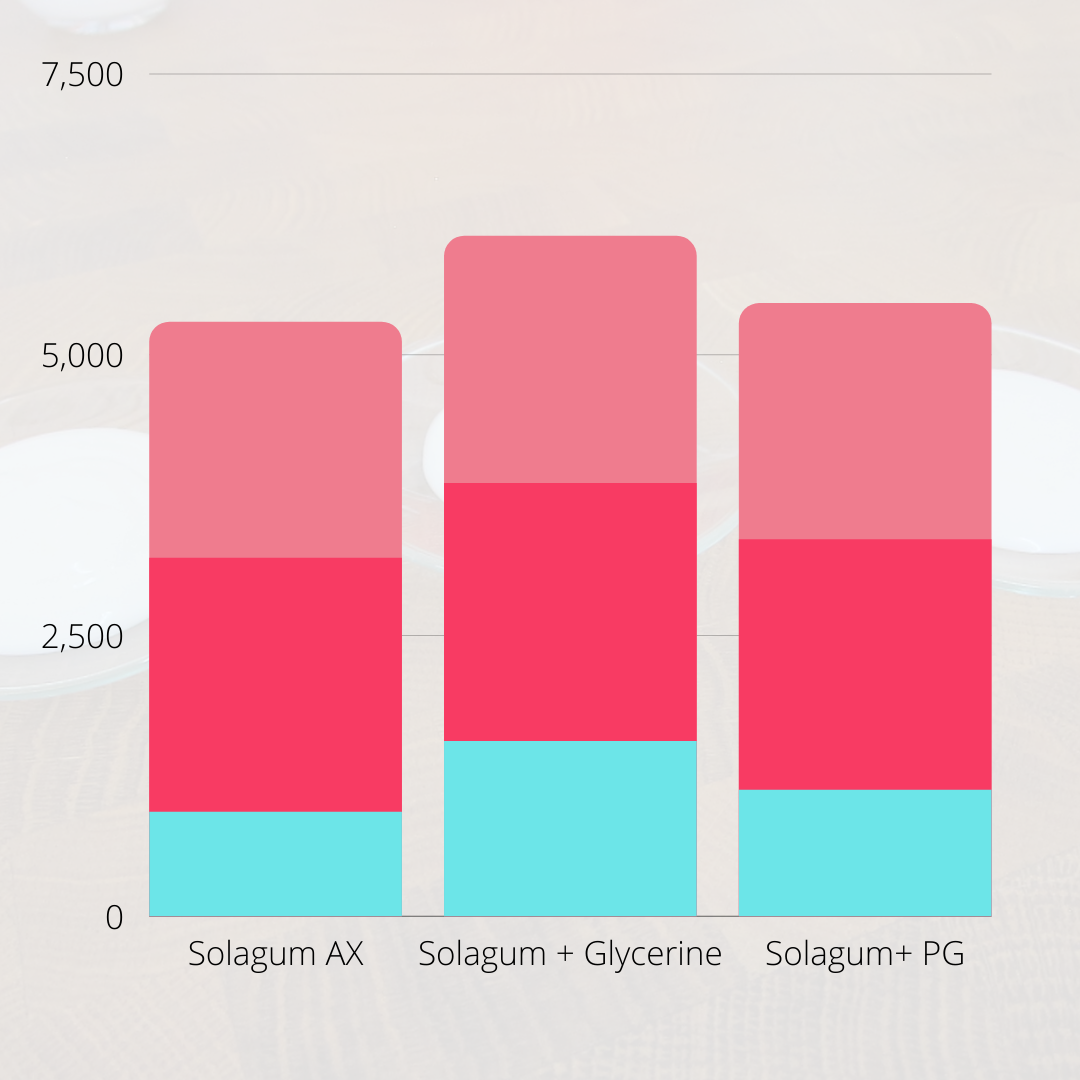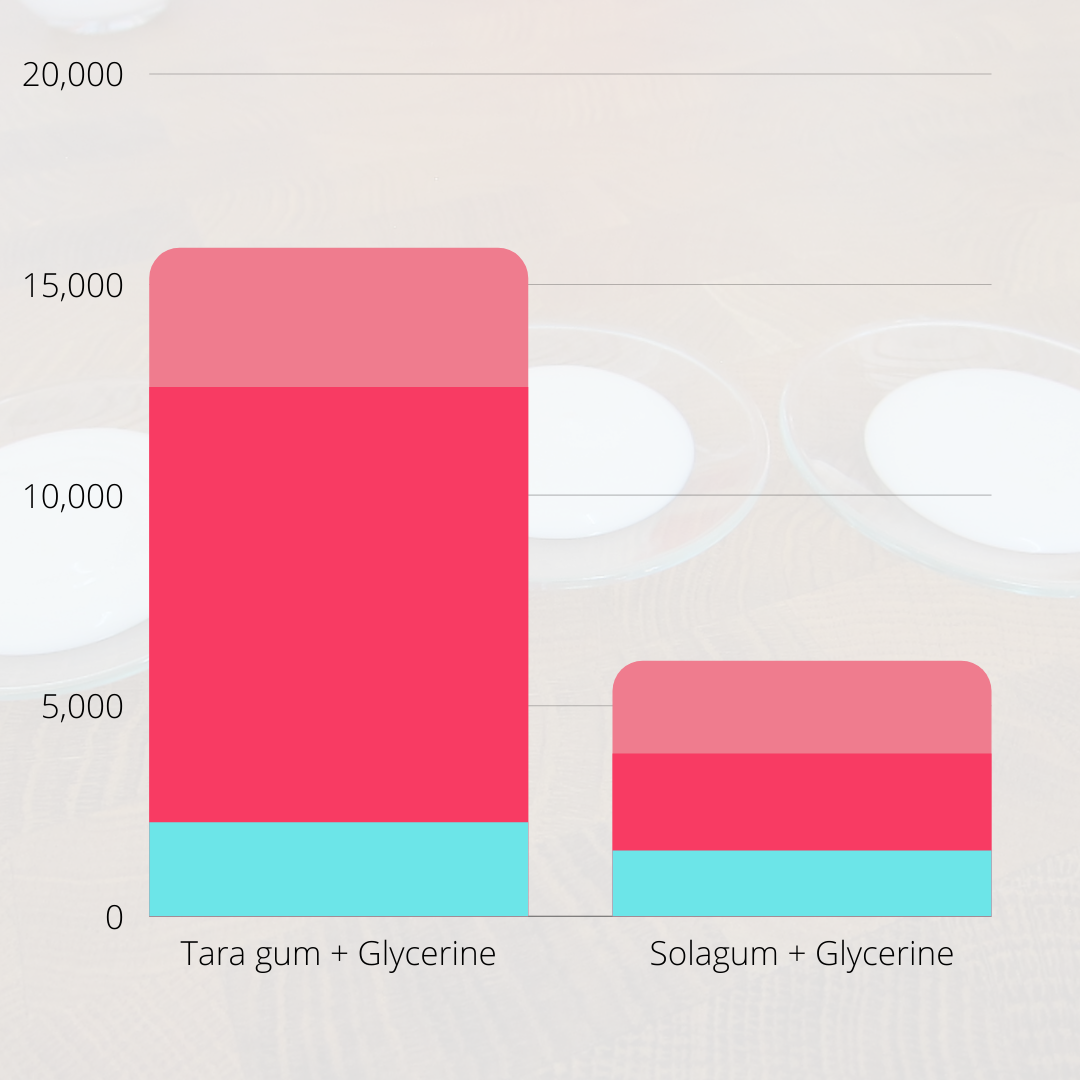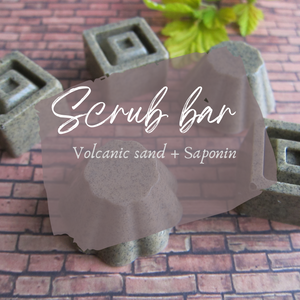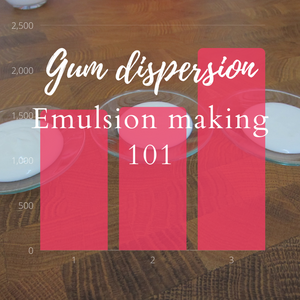
Personally I find natural gums one of the most humble but fascinating cosmetic ingredients and I have spent the last years studying and experimenting with them in a systematic way. Unfortunately there are very little information about natural gums in cosmetics and most of the information and knowledge I have gained was from the books written for the food industry.
We have published tens of blog posts about natural gums in the past and I am in the process of collecting all the material in an ebook or an online course (please let me know which one you prefer and what specific information and skills you are looking for. This helps a lot)
Anyway in our last post we showed you the impact of the gum dispersion on the viscosity of the product. We have dispersed the gum in 3 ways:
1- Add the gum directly to the cold oil phase before heating the oil phase
2- Blend the gum+ glycerine and add this blend to the hot emulsion
3- Blend the gum+ glycerine and add this blend to cold water phase before heating the water phase
There are 1001 ways (well perhaps not exactly that much but still many ways) to incorporate a gum in a formulation and often there is no "right" or "wrong". There is certainly a difference in the outcome and it is your task as a formulator to experiment different ways and come up to the one method that works best for you and your formulation.
In the last post's experiment for example we used Solagum AX which is a proprietary blend of xanthan gum and acacia gum. This gum doesn't need any heat for complete hydration. You just need to hydrate it effectively, no matter if you hydrate it cold or hot. This means you can as well use this gum in a cold process emulsion and get the full potential of it.
Blending the gum in a non-hydrating carrier such as glycerine (or the oil phase) improves the hydration. This is very important and significant if you are working in small volumes and in an Artisanal lab and do not use a high-end overhead stirrer for the dispersion and hydration.
I know that some formulators do not like glycerine in leave-on formulations. Glycerine is an amazing humectant but imparts some tackiness that is unpleasant at extremely dry or extremely humid climate.
To expand our experiment from the last week and to answer your question:
what shall I do if I don't want to use glycerine ?
we ran another series of experiments. The base formulation is the same as in the previous post.
1- We used Solagum AX alone and dispersed it:
a- in the cold water phase before heating the water phase
b- in the hot emulsion directly after homogenization
c- in the cold emulsion after the emulsion has reached the RT
2- We used Solagum AX+ glycerine and we dispersed the blend
a- in the cold water phase before heating the water phase
b- in the hot emulsion directly after homogenization
c- in the cold emulsion after the emulsion has reached the RT
3- We used Solagum AX+ plant based pentylene glycol and we dispersed the blend
a- in the cold water phase before heating the water phase
b- in the hot emulsion directly after homogenization
c- in the cold emulsion after the emulsion has reached the RT
Glycols are solvents that cut through the stickiness and have a much more pleasant skin feel compared to glycerine. In addition to that the pentylene glycol (PG) is a preservative booster by reducing the water activity.
The following diagram shows our results in viscosity. All of the samples have passed the stability testing

The blue part of the diagram is the viscosity when we dispersed each gum and gum blend in cold water. There is a slight difference between all 3 variations. Blending the gum in glycerine increases the viscosity much more than blending with pentylene glycol. The dark pink area is the viscosity as we dispersed each gum in the hot emulsion and the light pink area is when we dispersed the gum in the cold emulsion. There is a difference between the results and the gum+glycerine blend leads to the highest viscosity in each experiment but the difference is not really huge. This means that if you don't like to use glycerine you can blend your gum with PG or even use the gum alone and disperse it in the hot or cold emulsion. (if you don't have a high-end overhed stirrer there will be a more significant difference when you blend the gum with a non-hydrating carrier)
These experiments are all with Solagum AX which , as I explained before does not need heat for dispersion and you can see quite clearly on the diagram that the difference is not quite dramatic. You will perhaps not even realize the difference by visual observation of the samples. The samples with the pG have the least tackiness and the nicest skin feel.
What if the gum needs heat for hydration?
The results will be completely different when you are using that needs heat for hydration.

The above diagram shows our comparative results between tara gum which usually creates a much higher viscosity compared to xanthan gum or Solagum AX but which needs heat for complete hydration.
Here again we blended the gum with the glycerine and used 3 methods of dispersion:
The blue part of the diagram is the viscosity when we dispersed the gum blend in cold water. There is a slight difference between tara gum and Solagum AX because in cold water tara gum is not fully hydrated. The dark pink area is the viscosity as we dispersed each gum blend in the hot emulsion and the light pink area is when we dispersed the gum blend in the cold emulsion. Here there is a huge difference between tara gum and the Solagum AX in hot emulsion but when we add the gum blend in the cold emulsion the difference is not significant again.
This means when you are working with a gum that needs heat for hydration you definitely need to disperse the gum in the hot water phase or in the hot emulsion. The emulsifier we used in this experiment is a hot-process emulsifier. This means that even though we dispersed the gums in the cold water phase (the blue part of the diagram), we heated the water phase together with the oil phase before emulsification but apparently the short heating time was not enough for the full hydration of tara gum. (Did I mention that gums are fascinating?)
I hope these experiments inspire you to play with your gums and the gum systems that you are using. As I mentioned before there is no "right" or "wrong". You just need to find out which method works the best in your formulation and with the equipment you are using.
If you want to know more about gums and which factors you need to take care of before selecting a certain gum use the following link to access my PDF file.
I'll come back and share more results within the coming weeks


